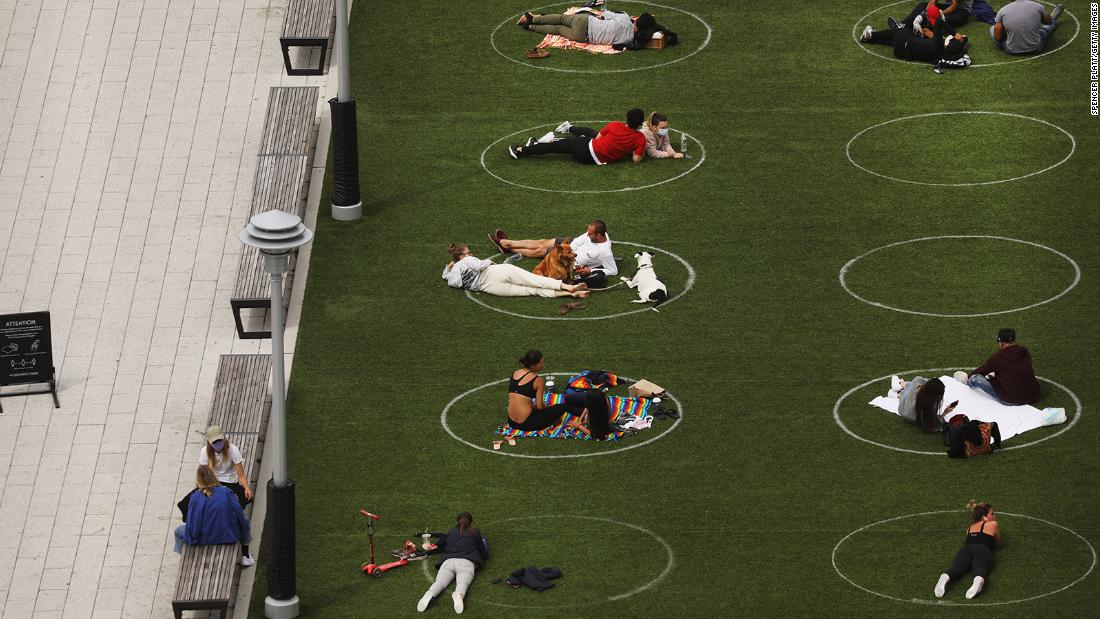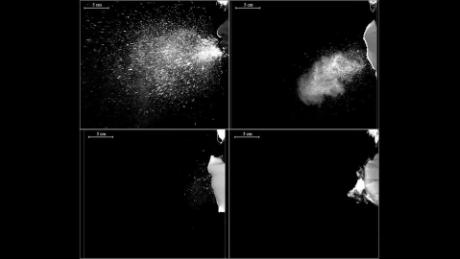But that evolution – and the changing information and recommendations that accompanied it – has also sown confusion, and in some cases, deliberate disinformation.
„Just as Covid-19 has spread around the world, so too have rumors, untruths and disinformation. And they can be just as dangerous,” Tedros Adhanom Ghebreyesus, director-general of the World Health Organization, said on Wednesday.
Mis- or disinformation has led to people harming themselves based on falsehoods, self-medicating with toxic chemicals or dangerous medications and not taking the precautions that they should be taking, Tedros said. It has also impacted our trust in institutions and health systems, which could result in people turning their backs on new treatments and vaccines if they don’t have confidence in them.
Tedros said
the WHO and its partners are „calling on all countries to put in place national action plans to promote science-based health information and to combat misinformation. And we call on the media, technology companies, civil society, researchers, and people everywhere to keep the ‘infodemic’ from spreading,” he said.
Here are some of the common myths and misconceptions floating around, and the state of the science as we understand it to date.
Misconception No. 1: Only older people are impacted by the virus
At a rally on Monday, President Trump said, „It affects elderly people. Elderly people with heart problems and other problems, if they have other problems. That’s what it really affects. That’s it. You know, in some states thousands of people – nobody young. Below the age of 18, like, nobody.”
The fact is people of all ages have been impacted by the virus. While older people are much more likely to get very sick with Covid-19, or die if they’re infected, younger people are by no means immune.
In fact,
a new study published Wednesday in the CDC’s Morbidity and Mortality Weekly Report found that young adults age 20 to 29 accounted for more than 20% of all confirmed Covid-19 cases in the United States during June, July and August – the highest incidence rate of all age groups.
The
National Center for Health Statistics has counted more than 1,800 Covid-19-related deaths in young people under the age of 35, including 419 in people under the age of 25;
851 children under the age of 18 have been hospitalized.
Older people may be more susceptible because they have more pre-existing conditions (called comorbidities) that make a coronavirus infection worse, or their immune systems may be weakened by age.
Some young people also have comorbidities that put them at greater risk of getting very sick. And in some children, the virus can cause their immune system to overreact, creating inflammation and unleashing a cascade of chemical reactions known as a cytokine storm, which wreaks havoc within the body. It’s a condition called multi-system inflammatory syndrome in children, known as MIS-C.
Misconception No. 2: Masks don’t protect you against coronavirus
This one is perhaps the most contentious and politicized misconception of all. Early in the pandemic, we were told masks weren’t important for those of us who were not coming into regular, close contact with sick people. Plus, because of shortages that continue to this day, we were asked to save the N-95 masks for frontline workers.
But masks became a must after we began to understand two very important facts. The first is that people can spread the virus even if they have no symptoms. And the second is that the virus very likely spreads through the air, in small virus-containing droplets called aerosols, and not only by a person coming into contact with an infected surface or large respiratory droplets.
Infectious disease expert Dr. Anthony Fauci addressed the reversal of the guidance on face masks during the CITIZEN by CNN conference on Tuesday. „One of the things that the public needs to understand is that this is an evolving situation,” he said.
„We were not aware that 40% to 45% of people were asymptomatic, nor were we aware that a substantial proportion of people who get infected get infected from people who are without symptoms. That makes it overwhelmingly important for everyone to wear a mask,” he said, noting that „the data now are very, very clear.”
How do masks work? Masks protect other people against the mask-wearer’s virus-containing droplets that are expelled into the air via breathing, sneezing, coughing, singing or shouting.
‘);$vidEndSlate.removeClass(‘video__end-slate–inactive’).addClass(‘video__end-slate–active’);}};CNN.autoPlayVideoExist = (CNN.autoPlayVideoExist === true) ? true : false;var configObj = {thumb: ‘none’,video: ‘app-health-section/2020/07/23/mask-test-study-wellness.cnn’,width: ‘100%’,height: ‘100%’,section: ‘international’,profile: ‘expansion’,network: ‘cnn’,markupId: ‘body-text_42’,theoplayer: {allowNativeFullscreen: true},adsection: ‘const-article-inpage’,frameWidth: ‘100%’,frameHeight: ‘100%’,posterImageOverride: {„mini”:{„width”:220,”type”:”jpg”,”uri”:”//cdn.cnn.com/cnnnext/dam/assets/200723185930-mask-test-study-wellness-00012808-small-169.jpg”,”height”:124},”xsmall”:{„width”:307,”type”:”jpg”,”uri”:”//cdn.cnn.com/cnnnext/dam/assets/200723185930-mask-test-study-wellness-00012808-medium-plus-169.jpg”,”height”:173},”small”:{„width”:460,”type”:”jpg”,”uri”:”//cdn.cnn.com/cnnnext/dam/assets/200723185930-mask-test-study-wellness-00012808-large-169.jpg”,”height”:259},”medium”:{„width”:780,”type”:”jpg”,”uri”:”//cdn.cnn.com/cnnnext/dam/assets/200723185930-mask-test-study-wellness-00012808-exlarge-169.jpg”,”height”:438},”large”:{„width”:1100,”type”:”jpg”,”uri”:”//cdn.cnn.com/cnnnext/dam/assets/200723185930-mask-test-study-wellness-00012808-super-169.jpg”,”height”:619},”full16x9″:{„width”:1600,”type”:”jpg”,”uri”:”//cdn.cnn.com/cnnnext/dam/assets/200723185930-mask-test-study-wellness-00012808-full-169.jpg”,”height”:900},”mini1x1″:{„width”:120,”type”:”jpg”,”uri”:”//cdn.cnn.com/cnnnext/dam/assets/200723185930-mask-test-study-wellness-00012808-small-11.jpg”,”height”:120}}},autoStartVideo = false,isVideoReplayClicked = false,callbackObj,containerEl,currentVideoCollection = [],currentVideoCollectionId = ”,isLivePlayer = false,mediaMetadataCallbacks,mobilePinnedView = null,moveToNextTimeout,mutePlayerEnabled = false,nextVideoId = ”,nextVideoUrl=””,turnOnFlashMessaging = false,videoPinner,videoEndSlateImpl;if (CNN.autoPlayVideoExist === false) {autoStartVideo = false;if (autoStartVideo === true) {if (turnOnFlashMessaging === true) {autoStartVideo = false;containerEl = jQuery(document.getElementById(configObj.markupId));CNN.VideoPlayer.showFlashSlate(containerEl);} else {CNN.autoPlayVideoExist = true;}}}configObj.autostart = CNN.Features.enableAutoplayBlock ? false : autoStartVideo;CNN.VideoPlayer.setPlayerProperties(configObj.markupId, autoStartVideo, isLivePlayer, isVideoReplayClicked, mutePlayerEnabled);CNN.VideoPlayer.setFirstVideoInCollection(currentVideoCollection, configObj.markupId);videoEndSlateImpl = new CNN.VideoEndSlate(‘body-text_42’);function findNextVideo(currentVideoId) {var i,vidObj;if (currentVideoId && jQuery.isArray(currentVideoCollection) && currentVideoCollection.length > 0) {for (i = 0; i 0) {videoEndSlateImpl.showEndSlateForContainer();if (mobilePinnedView) {mobilePinnedView.disable();}}}}callbackObj = {onPlayerReady: function (containerId) {var playerInstance,containerClassId = „https://edition.cnn.com/2020/09/26/health/coronavirus-myths-science-gupta/#” + containerId;CNN.VideoPlayer.handleInitialExpandableVideoState(containerId);CNN.VideoPlayer.handleAdOnCVPVisibilityChange(containerId, CNN.pageVis.isDocumentVisible());if (CNN.Features.enableMobileWebFloatingPlayer &&Modernizr &&(Modernizr.phone || Modernizr.mobile || Modernizr.tablet) &&CNN.VideoPlayer.getLibraryName(containerId) === ‘fave’ &&jQuery(containerClassId).parents(‘.js-pg-rail-tall__head’).length > 0 &&CNN.contentModel.pageType === ‘article’) {playerInstance = FAVE.player.getInstance(containerId);mobilePinnedView = new CNN.MobilePinnedView({element: jQuery(containerClassId),enabled: false,transition: CNN.MobileWebFloatingPlayer.transition,onPin: function () {playerInstance.hideUI();},onUnpin: function () {playerInstance.showUI();},onPlayerClick: function () {if (mobilePinnedView) {playerInstance.enterFullscreen();playerInstance.showUI();}},onDismiss: function() {CNN.Videx.mobile.pinnedPlayer.disable();playerInstance.pause();}});/* Storing pinned view on CNN.Videx.mobile.pinnedPlayer So that all players can see the single pinned player */CNN.Videx = CNN.Videx || {};CNN.Videx.mobile = CNN.Videx.mobile || {};CNN.Videx.mobile.pinnedPlayer = mobilePinnedView;}if (Modernizr && !Modernizr.phone && !Modernizr.mobile && !Modernizr.tablet) {if (jQuery(containerClassId).parents(‘.js-pg-rail-tall__head’).length) {videoPinner = new CNN.VideoPinner(containerClassId);videoPinner.init();} else {CNN.VideoPlayer.hideThumbnail(containerId);}}},onContentEntryLoad: function(containerId, playerId, contentid, isQueue) {CNN.VideoPlayer.showSpinner(containerId);},onContentPause: function (containerId, playerId, videoId, paused) {if (mobilePinnedView) {CNN.VideoPlayer.handleMobilePinnedPlayerStates(containerId, paused);}},onContentMetadata: function (containerId, playerId, metadata, contentId, duration, width, height) {var endSlateLen = jQuery(document.getElementById(containerId)).parent().find(‘.js-video__end-slate’).eq(0).length;CNN.VideoSourceUtils.updateSource(containerId, metadata);if (endSlateLen > 0) {videoEndSlateImpl.fetchAndShowRecommendedVideos(metadata);}},onAdPlay: function (containerId, cvpId, token, mode, id, duration, blockId, adType) {/* Dismissing the pinnedPlayer if another video players plays an Ad */CNN.VideoPlayer.dismissMobilePinnedPlayer(containerId);clearTimeout(moveToNextTimeout);CNN.VideoPlayer.hideSpinner(containerId);if (Modernizr && !Modernizr.phone && !Modernizr.mobile && !Modernizr.tablet) {if (typeof videoPinner !== ‘undefined’ && videoPinner !== null) {videoPinner.setIsPlaying(true);videoPinner.animateDown();}}},onAdPause: function (containerId, playerId, token, mode, id, duration, blockId, adType, instance, isAdPause) {if (mobilePinnedView) {CNN.VideoPlayer.handleMobilePinnedPlayerStates(containerId, isAdPause);}},onTrackingFullscreen: function (containerId, PlayerId, dataObj) {CNN.VideoPlayer.handleFullscreenChange(containerId, dataObj);if (mobilePinnedView &&typeof dataObj === ‘object’ &&FAVE.Utils.os === ‘iOS’ && !dataObj.fullscreen) {jQuery(document).scrollTop(mobilePinnedView.getScrollPosition());playerInstance.hideUI();}},onContentPlay: function (containerId, cvpId, event) {var playerInstance,prevVideoId;if (CNN.companion && typeof CNN.companion.updateCompanionLayout === ‘function’) {CNN.companion.updateCompanionLayout(‘restoreEpicAds’);}clearTimeout(moveToNextTimeout);CNN.VideoPlayer.hideSpinner(containerId);if (Modernizr && !Modernizr.phone && !Modernizr.mobile && !Modernizr.tablet) {if (typeof videoPinner !== ‘undefined’ && videoPinner !== null) {videoPinner.setIsPlaying(true);videoPinner.animateDown();}}},onContentReplayRequest: function (containerId, cvpId, contentId) {if (Modernizr && !Modernizr.phone && !Modernizr.mobile && !Modernizr.tablet) {if (typeof videoPinner !== ‘undefined’ && videoPinner !== null) {videoPinner.setIsPlaying(true);var $endSlate = jQuery(document.getElementById(containerId)).parent().find(‘.js-video__end-slate’).eq(0);if ($endSlate.length > 0) {$endSlate.removeClass(‘video__end-slate–active’).addClass(‘video__end-slate–inactive’);}}}},onContentBegin: function (containerId, cvpId, contentId) {if (mobilePinnedView) {mobilePinnedView.enable();}/* Dismissing the pinnedPlayer if another video players plays a video. */CNN.VideoPlayer.dismissMobilePinnedPlayer(containerId);CNN.VideoPlayer.mutePlayer(containerId);if (CNN.companion && typeof CNN.companion.updateCompanionLayout === ‘function’) {CNN.companion.updateCompanionLayout(‘removeEpicAds’);}CNN.VideoPlayer.hideSpinner(containerId);clearTimeout(moveToNextTimeout);CNN.VideoSourceUtils.clearSource(containerId);jQuery(document).triggerVideoContentStarted();},onContentComplete: function (containerId, cvpId, contentId) {if (CNN.companion && typeof CNN.companion.updateCompanionLayout === ‘function’) {CNN.companion.updateCompanionLayout(‘restoreFreewheel’);}navigateToNextVideo(contentId, containerId);},onContentEnd: function (containerId, cvpId, contentId) {if (Modernizr && !Modernizr.phone && !Modernizr.mobile && !Modernizr.tablet) {if (typeof videoPinner !== ‘undefined’ && videoPinner !== null) {videoPinner.setIsPlaying(false);}}},onCVPVisibilityChange: function (containerId, cvpId, visible) {CNN.VideoPlayer.handleAdOnCVPVisibilityChange(containerId, visible);}};if (typeof configObj.context !== ‘string’ || configObj.context.length 0) {configObj.adsection = window.ssid;}CNN.autoPlayVideoExist = (CNN.autoPlayVideoExist === true) ? true : false;CNN.VideoPlayer.getLibrary(configObj, callbackObj, isLivePlayer);});CNN.INJECTOR.scriptComplete(‘videodemanddust’);
Some studies have found that masks can reduce the amount of droplets that a person breathes into the air by up to 90%. And one study found that masks reduce the transmission of respiratory viruses by as much as 56% percent.
But not all masks are created equal, so
choose wisely. Surgical masks – the paper ones that doctors wear – have an electrostatically-charged filter that grabs viral particles like a blanket grabs your socks in the dryer. Avoid masks with valves; while they make it a bit easier to breath out, they release unfiltered air – so, if the wearer is contagious, it doesn’t protect others, which defeats the purpose of the mask in the first place.
„The interesting thing about that is it doesn’t change anything that we’ve been saying,” said Fauci during Tuesday’s conference. „It means wear your mask, it means avoid close contact, it means avoid crowds.”
Fauci also reiterated, „Outdoors is better than indoors, because if you have aerosol indoors, you can have some recirculation.”
Consider that studies have shown an estimated
80% of cases originate from just about 10% to 20% of people. It’s not because these individuals are somehow different, but rather
the situations they’re in: crowded indoor spaces like bars, restaurants, factories and jails or gatherings that bring people closely together likes weddings or church – events and spaces that light the match of transmission.
But it isn’t, really. It’s true that both Covid-19 and the flu are caused by respiratory viruses and may share some similar symptoms including fever, fatigue and cough. And in both cases, some people have milder symptoms than others.
But there are also big differences. While the numbers change depending on location and timeframe, according to the CDC’s most
recent best-guess, the likelihood of dying from Covid-19 – the infection fatality ratio– is very low for people under the age of 50. But for people age 50 to 69, it is 0.5%, and for people 70 and older, it jumps up to 5.4%. The overall chances of dying from the flu
are about 0.1%.
According to the CDC, „These deaths could represent misclassified COVID-19 deaths, or potentially could be indirectly related to the COVID-19 pandemic (e.g., deaths from other causes occurring in the context of health care shortages or overburdened health care systems).”
There’s been a lot of speculation around when we will have a vaccine, with some optimistic projections as early as October. Several of the developers anticipate having data to share this fall.
But Fauci and other public health leaders have said that it is highly unlikely a vaccine will be available by Election Day. And the US Food and Drug Administration is considering new rules for authorization for a Covid-19 vaccine, according to three sources familiar with the situation, and calculations show these rules would push an authorization beyond Election Day.
That would dash the hopes of President Trump, who has said repeatedly the vaccine could be ready by November 3.
„If it’s shown efficacious in November or in December, we don’t have enough vaccine doses. We’d have a few million in November and maybe 10, 20 million of each in December. That will be enough to … start vaccinating certain populations but not the whole population,” Dr. Moncef Slaoui told me. Slaoui is head of Operation Warp Speed, the government’s vaccine initiative.
Slaoui – who noted that it’s not even a given that any vaccine will be effective enough because the data aren’t in – said certain groups, such as health care workers and people who are vulnerable to the disease, would be prioritized. „For the rest of us, it is looking more like mid-2021,” he said, a timeline also put forward by Fauci.
Slaoui also circled back to what Fauci and others have been stressing. „Let’s stay focused on what science tells to help us overcome this. I’m excited as anyone about getting a vaccine – but in the meantime there are simple and effective things we can do ourselves: wash our hands, avoid large gatherings and wear a mask.”



